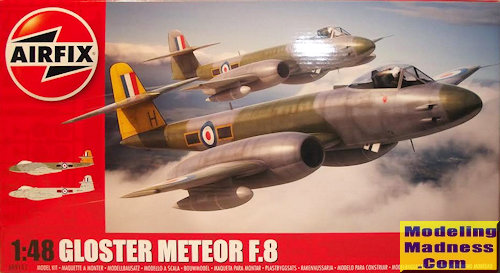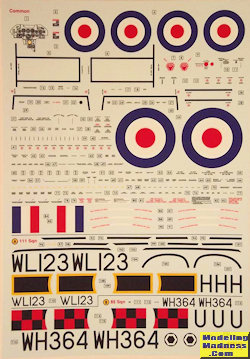
Airfix 1/48 Meteor F.8
| KIT #: | A09182 |
| PRICE: | £29-99 |
| DECALS: | Two Options |
| REVIEWER: | Frank Reynolds |
| NOTES: |

| HISTORY |
First flown in March 1943, the Gloster Meteor was the Allies’ first jet fighter to see squadron service, with limited operations by the Royal Air Force in the closing months of World War 2. Although its jet power plant was cutting edge technology, the airframe construction was wholly conventional for the period and this permitted a long series of modifications to the basic design, eventually allowing it to evolve from a single seat day fighter to a two seat radar equipped night fighter. Early jets were noted for a prodigious thirst for fuel and an early development of the Meteor resulted in a fixed belly tank and two under wing tanks. The most developed fighter variant was the Mk.8, in production from 1949 to 1954. A further upgrade provided for the installation of an additional fuselage tank behind the pilot and a new more aerodynamic tail assembly. Although quickly outclassed as a pure fighter the rugged and reliable Meteor was the backbone of the RAF’s Fighter Command during the early Cold War years. For a near-bankrupt post-war Britain the Meteor was a welcome export success with the F.8 supplied to Australia, Belgium, Brazil, Denmark, Egypt, Israel, The Netherlands and Syria.
As a modelling subject the Meteor has so much potential with colour schemes varying from overall silver paint to the drab grey/green of European air forces and desert camouflage finishes of the Middle East. Many squadrons of the Royal Air Force decorated their fighters with the bold colours of heraldry and it would take close to a modelling lifetime to cover them all.
| THE KIT |
 There
are five parts frames in Airfix’s now familiar pale blue-grey plastic and one of
clear. (I have shown one as an example. Ed) Surface detailing is mainly recessed
panel lines that some may consider a trifle too deep but they look as if they
will be OK under a coat of acrylic.
There
are five parts frames in Airfix’s now familiar pale blue-grey plastic and one of
clear. (I have shown one as an example. Ed) Surface detailing is mainly recessed
panel lines that some may consider a trifle too deep but they look as if they
will be OK under a coat of acrylic.
An A4 sized instruction book runs to 16 pages and 98 steps of construction. There are two pages of A-3 colour three-views as a colour and decals placement guide and a separate stencils diagram.
 Decals
are provided for two options, both RAF. First is camouflaged with Dark Green and
Dark Grey upper surfaces over Silver under surfaces. Representing an aircraft of
No 111 Squadron, North Weald, 1954, it features the Squadron Leader’s all-yellow
tail fin. Second is an all silver aircraft of No.85 Squadron, Binbrook, 1968.
Although this has all the appearance of a classic fighter squadron’s colours, by
1968 85 Squadron was a target facilities unit and this Meteor wore its flashy
colours in a more humble target towing role. (As an interesting note, 85
Squadron was a Bloodhound SAM unit from 1975 until the end of the Cold War in
1991 when it became a basic training squadron(R). It was permanently disbanded
in 2011). Ed)
Decals
are provided for two options, both RAF. First is camouflaged with Dark Green and
Dark Grey upper surfaces over Silver under surfaces. Representing an aircraft of
No 111 Squadron, North Weald, 1954, it features the Squadron Leader’s all-yellow
tail fin. Second is an all silver aircraft of No.85 Squadron, Binbrook, 1968.
Although this has all the appearance of a classic fighter squadron’s colours, by
1968 85 Squadron was a target facilities unit and this Meteor wore its flashy
colours in a more humble target towing role. (As an interesting note, 85
Squadron was a Bloodhound SAM unit from 1975 until the end of the Cold War in
1991 when it became a basic training squadron(R). It was permanently disbanded
in 2011). Ed)
The smallish decal sheet is crammed with 116 numbered subjects, some duplicated, to include a mass of stenciling. It is sharply printed and looks to be of good quality.
The plastic parts appear cleanly moulded with no evidence of flash or short shots. Two of the parts frames appear to be slightly twisted and this might lead to problems in assembly but no chronic problems were apparent.
Airfix has really gone to town with the details and options on this kit, as seems to be the norm with their new releases over the last couple of years. There are well detailed gear bays with front and rear wing spars, detailed machine gun bays either side of the nose and although there is no pilot figure, an optional ejector seat cushion has moulded in seat belts. There are some delightful detail touches such as the target towing lug to be attached under the belly for one version and a pilot’s foot step. The cockpit has well defined raised relief side wall detail and an instrument panel decal.
All of the main control surfaces are moulded separately and can be pose deflected. Two engine sets are provided which can be shown off through the detachable wing cowlings and an engine stand provides diorama potential. Optional engine intakes are included, the early small diameter and later, larger type. There is a retracted undercarriage option and the air brakes can be shown open. Both belly and underwing fuel tanks are offered.
The moulding show some hint of what Airfix may have in mind for future releases. There is an unused clear moulding for the early type of canopy with a solid rear fairing and the unmistakable shape of the camera windows of an FR.9. The outer lower wing panels each have eight flashed over holes which suggest a rocket installation. Finally the Mk.8 fuselage parts have their own parts frame, so a T.7 or F.4 might be an option for this manufacturer.
| CONCLUSIONS |
This is a brilliant choice of subject that has so much potential. There is enough detail in the kit to provide the basis for a great model. If it builds as well as the recent crop of Airfix kits all should be well, the only caveat being Airfix’s slightly patchy quality control with warped parts in some kits. The opportunities for aftermarket decal manufacturers are legion. My LHS sold out their supplies almost on arrival and my order for a second one is already in.
Airfix categorise this kit as a series 9, so with the recent price hike in the UK market place it is not cheap, but reasonable value for what is on offer.
March 2016
Copyright ModelingMadness.com
Sample courtesy of my LHS, Spot on Models and Games of Swindon, England
If you would like your product reviewed fairly and fairly quickly, please contact the editor or see other details in the Note to Contributors.